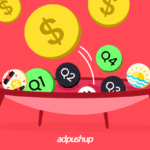Discover the 17 best mobile ad networks for publishers in our 2025 update. Find the perfect network to maximize your ad monetization and reach your target audience effectively.
Mobile devices have taken over the world in the last decade, with the number of internet users surpassing desktop users. The ad tech industry responded to this change by launching multiple mobile-specific ad networks.
In fact, according to Statista, by 2026, it is estimated that consumers will download a staggering 143 billion mobile apps from the Google Play Store. This represents a significant increase of nearly 30 percent compared to the 111 billion apps downloaded in 2021.
To address this growing need, we present an updated list of the top 17 mobile ad networks for publishers in 2025. These ad networks offer diverse features, targeting capabilities, and revenue opportunities, empowering publishers to maximize their ad monetization potential in the dynamic mobile advertising ecosystem.
But first, let’s understand what mobile networks are.
What is a Mobile Ad Network?
Mobile ad networks are the ad networks where app developers (publishers) and advertisers connect. These platforms facilitate distributing and managing advertisements specifically designed for mobile devices. Using mobile ad networks, publishers, mainly app developers, can sell their ad inventory to buyers/advertisers.
In other words, mobile ad networks serve as an intermediary between advertisers, who aim to promote their products or services, and publishers, who offer a mobile app or website inventory to display those ads.
How Does a Mobile Ad Network Work?
- When a publisher or app owner joins a mobile ad network, the network gains access to their ad space and user data
- Advertisers create campaigns on the network, setting up audience targeting, budget, and frequency capping
- Once everything is set up, the ad network steps in whenever a user opens the publisher’s app
- Each time the app is accessed, ad new ad space is triggered, ready for monetization
- The mobile ad network matches this ad space to an advertiser’s campaign based on their requirements, ensuring relevant ads reach the right audience.
- Finally, the ad is served on the users’ screen.
Top 17 Mobile Ad Networks for Publishers in 2025
There are plenty of mobile ad networks out there. As per Statista, the most popular is Google AdsMob, followed by its mediation adapters, Facebook audience network, and more. Now without further ado, let’s get to the list of mobile ad networks.
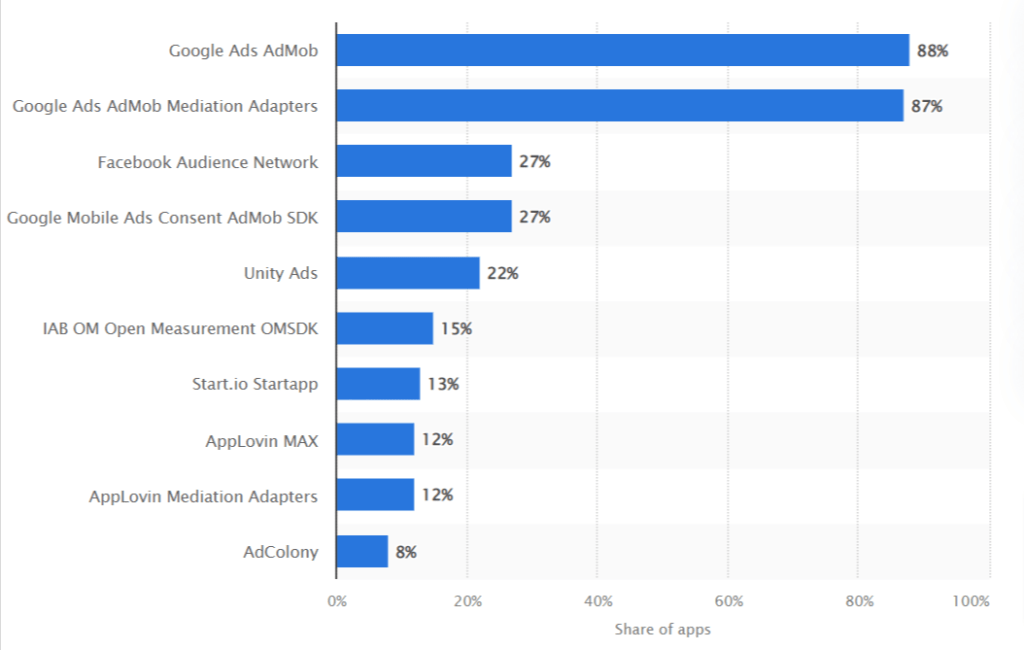
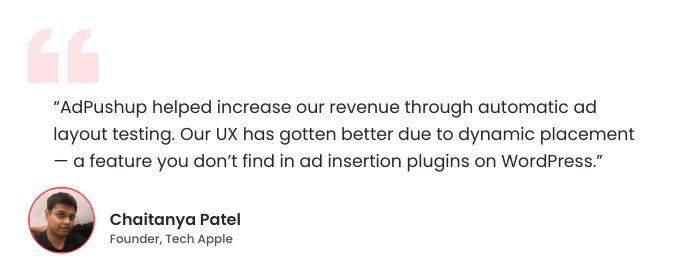
1. AdPushup
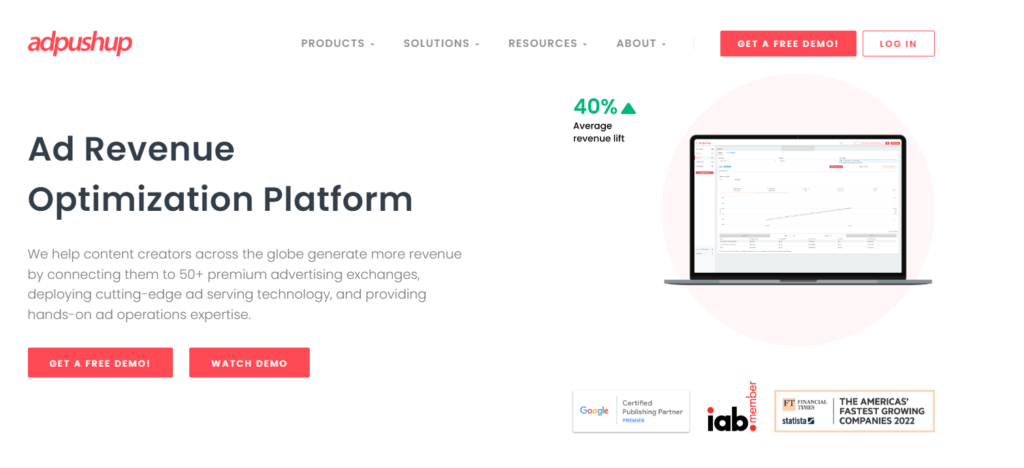
AdPushup is an ad partner cum revenue optimization platform active in the industry since 2014. The company has been a pioneer in deploying A/B testing for ads. To increase the ad revenue for publishers, AdPushup employs advanced data-procuring methods and sophisticated analysis to find the loopholes and accordingly curate revenue-boosting ad strategies.
The company, armed with seasoned ad operations experts and statistical analysts, study the publisher’s digital assets to understand their needs in-depth. This level of personalization and customization makes AdPushup a top choice for publishers worldwide.
AdPushup works with some of the top advertisers including verified and best mobile ad networks to provide a seamless ad experience for users, while keeping in mind the publisher’s brand reputation.
Publishers across the US, Europe and Oceania have already partnered with AdPushup and have seen a guaranteed 30% increase in their ad revenue.
Pros
- User-friendly interface that can be easily navigated by publishers
- Offers AdBlock recovery feature to regain the lost revenue
- Offers innovative ad formats like butterfly ads to enhance visibility and CTR
Cons
- Publishers must have $3000 monthly revenue to be eligible for Adpushup
2. AdMob
The second in app ad network in the list, AdMob, is one of the most popular mobile ad networks, which was founded in April 2006 as a mobile advertising platform. And later in November 2009, it was acquired by Google. AdMob offers advertising solutions for mobile platforms like Android, iOS, WebOS, Flash Lite, Windows phones, and all mobile web browsers.
Features
- AdMob claims to serve more than 40 billion mobile ads each month making it the world’s largest mobile ad network.
The demand is captured from Google Ads (formerly AdWords) accessing buyers from around the world. Ad formats are responsive and delivered with a seamless user experience. For applications, the ads are delivered during the nature breaks to maximize engagement and to reduce intrusion.
Similarly, AdMob puts a great deal into user satisfaction while carefully building up the publisher’s revenue. As with most Google products, you can expect near-flawless functionality and easy app integration. If you’re a beginner in the mobile advertising game, then there is no better starting point than AdMob.
Pros
- Highly suitable for beginners are most of the processes are automated
- Has verified pool of advertisers
- Free of charge
- Seamless integration with Google Analytics to track ad performance
Cons
- Stringent limitations on website’s content
- Payout starts at $100 so small websites may have to wait for months before actually earning
- Difficult to recover account if the publisher breaks Google’s guidelines
3. Audience Network

Meta’s Audience Network is another effective mobile ad network for publishers seeking to optimize their monetization strategies. Backed by the extensive resources of Meta, this platform offers robust support for publishers and demonstrates particular expertise in mobile apps.
Meta’s Audience Network enables both advertisers and publishers to optimize their revenue potential. Its intuitive and user-friendly interface is widely recognized, empowering smaller businesses to fully leverage the platform’s comprehensive capabilities.
From monetization tips to bidding basics, you can find everything on Audience Network to help you make money from your app.
Pros
- Meta has a wide reach, which extends the reach of ads beyond Meta-owned platforms like Facebook and Instagram.
- Supports various ad formats, including banners, interstitials, native ads, and video ads.
Cons
- Like many ad networks, it can be affected by ad blockers, which can reduce the number of ads displayed and impact revenue.
- Being tied to Meta means that any changes in Meta’s policies or performance can directly impact the network’s effectiveness.
3. Start.io
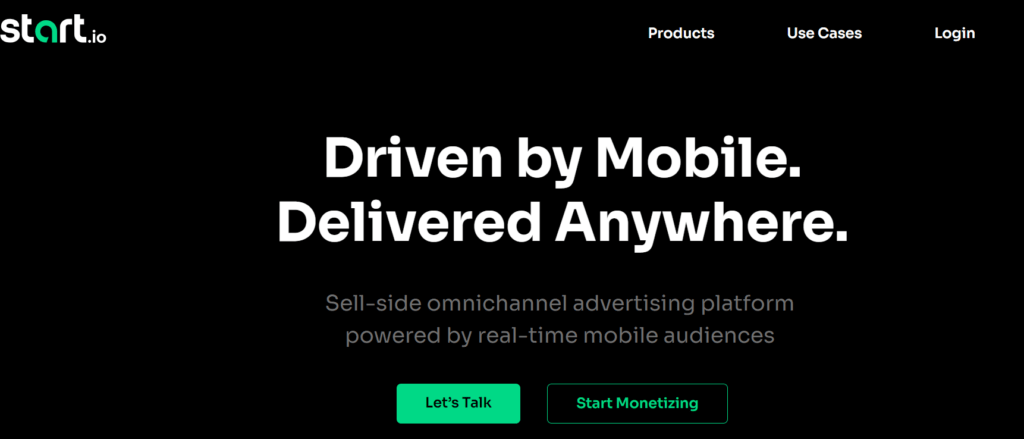
Next mobile ad network in the list, Start.io is an insight-driven mobile technology company that aims to maximize the publisher’s eCPMs, fill rates, engaged users, and revenue. This is achieved by advanced data insight used by the company to channel ads via programmatic and direct deals.
The company is partnered with Yandex, Oracle, Oath, and Baidu; and these businesses use Start.io’s technology and data solutions. Moreover, it is one of the highest paying mobile ad networks.
Pros
- Automated selection of relevant ads for your app
- Supports a variety of ad formats like interstitial ads, rich media ads, splash ads, etc.
- Employs data-driven targeting options to help publishers earn high eCPM
Cons
- Many publishers are not comfortable with interstitial ads being shown on their website
4. InMobi
InMobi has developed a new way of targeting users which they call appographic targeting. Appographic targeting increases the chance of connecting users to the type of media and apps that they are most likely to consume. For instance, if a user is booking a flight via an app, then the ads for hotels and tourism services would appear on the user’s screen.
It does this by basing the targeting on the users’ existing and previous applications instead of traditional metrics such as demographics or geography.
Other than that, InMobi offers in-app monetization, ad mediation, and audience bidding for publishers. And for mobile inventory, it deals in display, native, and video ad formats. Currently, it’s working with large publishers like ABC, TMZ, BlackBerry, Pandora, and wattpad.
Pros
- Offer real-time bidding
- No setup fee
- Advanced targeting capabilities compared to other ad networks
Cons
- Weak anti-ad fraud detection measures
- Have been known to track consumers without their consent
- Lack of adequate technical support for publishers
5. Media.net
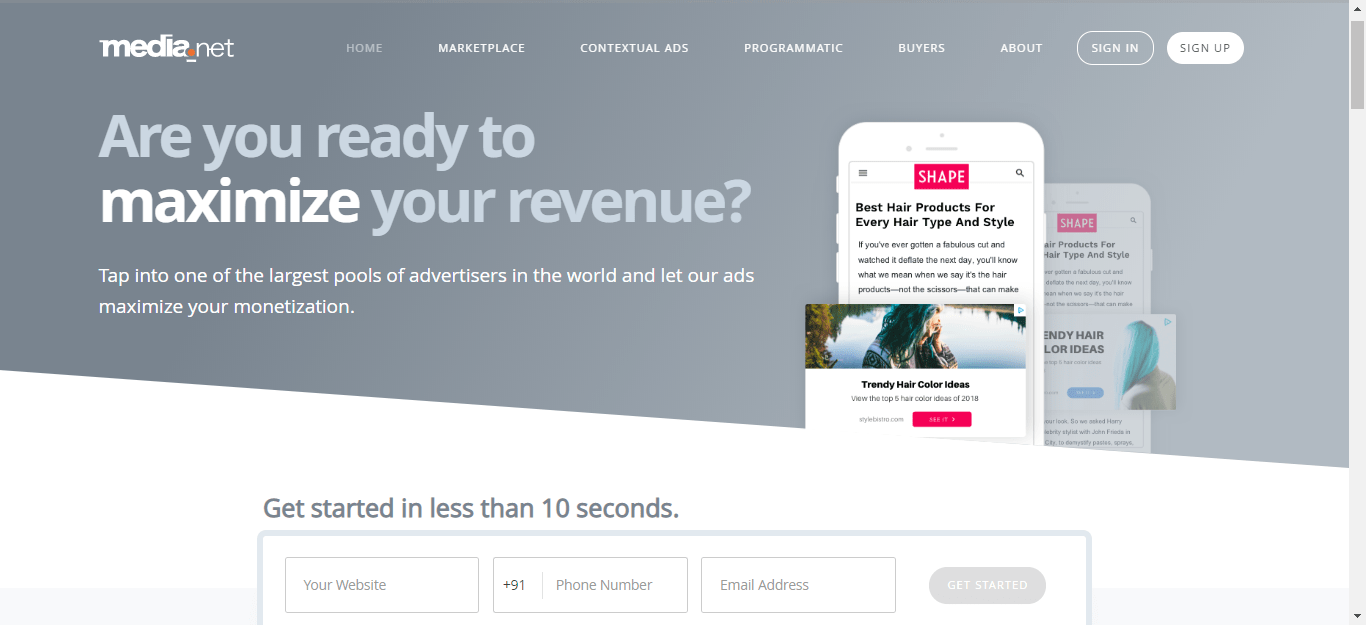
Media.net has one of the most comprehensive portfolios of advertising technology in the industry across search, display, mobile, native, local, products, and video.
Features
- Sophisticated audience- and contextual-based advertising targeting possibilities.
- Pioneer of display-to-search (D2S) ad format, a highly sophisticated method of monetizing display placements by identifying user search intent and displaying relevant search keywords that lead to the display of search ads bought by advertisers on a cost-per-click (CPC) pricing model.
- High conversion/sales seen by advertisers through this format without the risk of having to buy cost-per-thousand-impressions (CPM) based media where they run the risk of paying for media with which users did not engage.
- Real-time analytics and reporting to track income and ad performance.
Pros
Here are some unique benefits one can derive by running mobile ad units from Media.net:
- Competitive CPMs because the demand on mobile for search is nearly the same as desktops (and increasing!) and this drives the effective revenues significantly higher, vis-a-vis the conventional display demand from other ad providers, which is usually lower and limited in terms of dollar spends
- Mobile “in-content” units are responsive in nature and support all iOS and Android devices. This allows the publisher to monetize every impression, across all devices from a single ad provider source
- An already established trend with many mobile sites is that of “infinite-scroll”, where the content keeps loading as the user scrolls further down on a site. Mobile ads from Media.net are capable of being “docked” on the screen and thus remain in the viewable region all through
- Ad units are fully customizable to blend with the look, feel, and layout of a site, thus giving a far “native” experience, which enhances the experience rather than destroying it.
Cons
- Requires traffic only from three countries – US, UK, and Canada
- Ads need to be clicked on twice for the publishers to earn revenue
- Invite-only ad network that can reject publishers if they don’t fulfill the criteria
Earn an additional 10% revenue for the first three months with our partner Media.net by signing up here.

AdPushup has helped more than 300 web publishers sustainably increase their ad CTRs, CPMs, and overall revenues without compromising on UX.
Take a look at how we delivered a 534% ad revenue uplift in 6 Months for CCNA7. If you want to learn how our technology can do the same for you, go ahead and request a demo.
6. InMobi
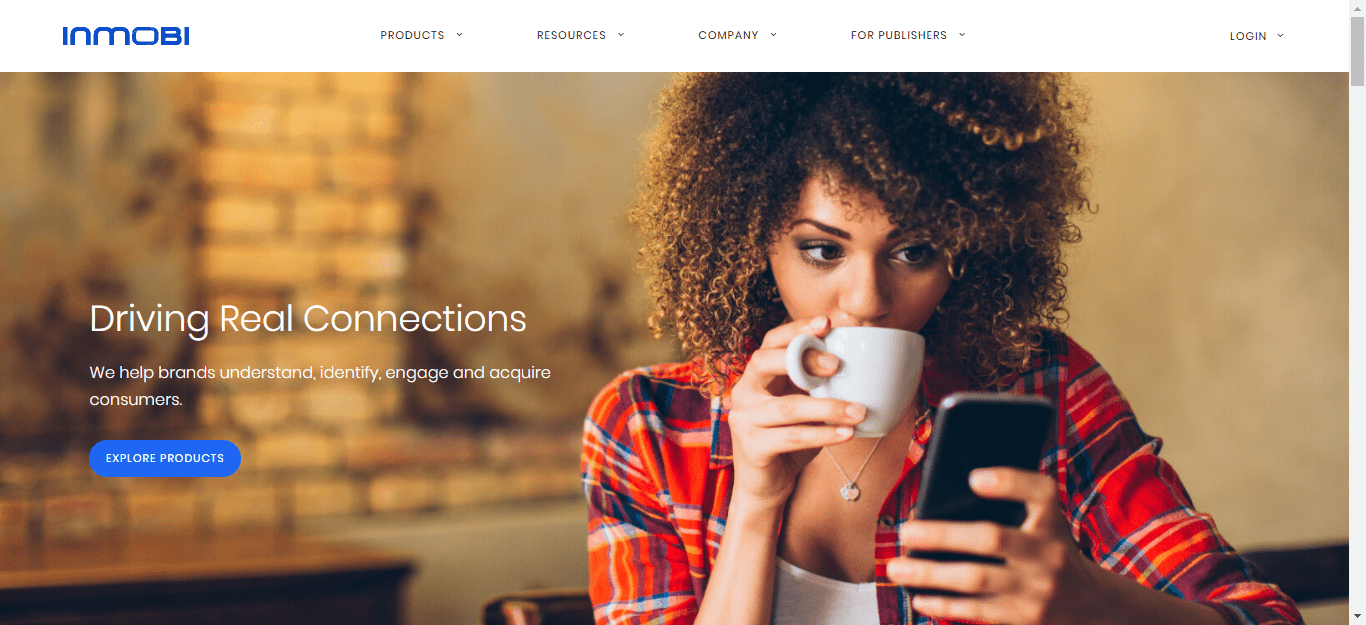
InMobi has developed a new way of targeting users which they call appographic targeting. Appographic targeting increases the chance of connecting users to the type of media and apps that they are most likely to consume. For instance, if a user is booking a flight via an app, then the ads for hotels and tourism services would appear on the user’s screen.
It does this by basing the targeting on the users’ existing and previous applications instead of traditional metrics such as demographics or geography.
Other than that, InMobi offers in-app monetization, ad mediation, and audience bidding for publishers. And for mobile inventory, it deals in display, native, and video ad formats. Currently, it’s working with large publishers like ABC, TMZ, BlackBerry, Pandora, and wattpad.
Pros
- Offer real-time bidding
- No setup fee
- Advanced targeting capabilities compared to other ad networks
Cons
- Weak anti-ad fraud detection measures
- Have been known to track consumers without their consent
- Lack of adequate technical support for publishers
7. Flurry
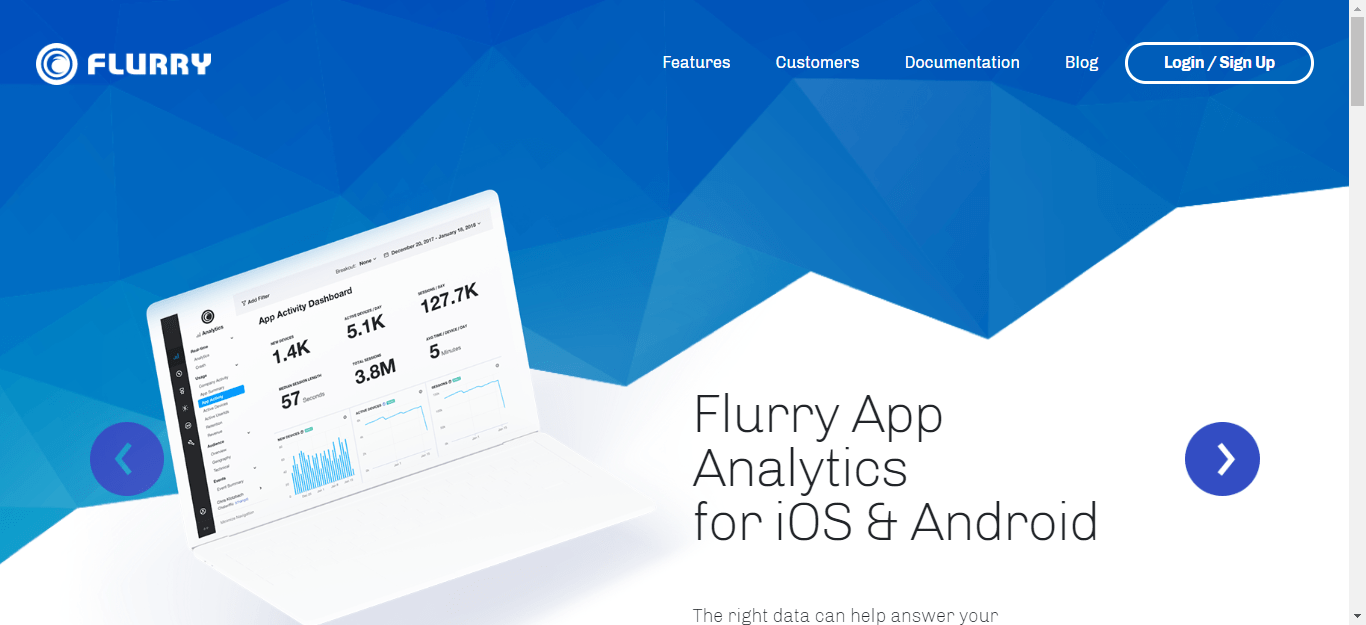
Flurry was acquired by Yahoo under Marissa Mayer’s reign in 2014. The analytics part of Flurry is something that is truly unique to them, with the ability for a developer or company to monitor a whole portfolio of applications distributed on different application stores across platforms.
Its funnels also measure customized consumer conversion metrics. You can also categorize the analytics that you gather, for example separating paid users from free users. Officially part of the Yahoo Developer Network and their App Publishing, Flurry shows great potential for high revenues with their extensive analytics features.
If you have the patience and the drive to optimize and test your ad campaigns over and over again, you can most certainly make some really interesting observations with Flurry.
Pros
- Developer and marketer friendly analytics
- Offers 23 audience segments for user targeting
- Offers user session recordings to see user app interactions
Cons
- Offers basic features, especially for seasoned advertisers or publishers looking to expand their reach
8. Smaato
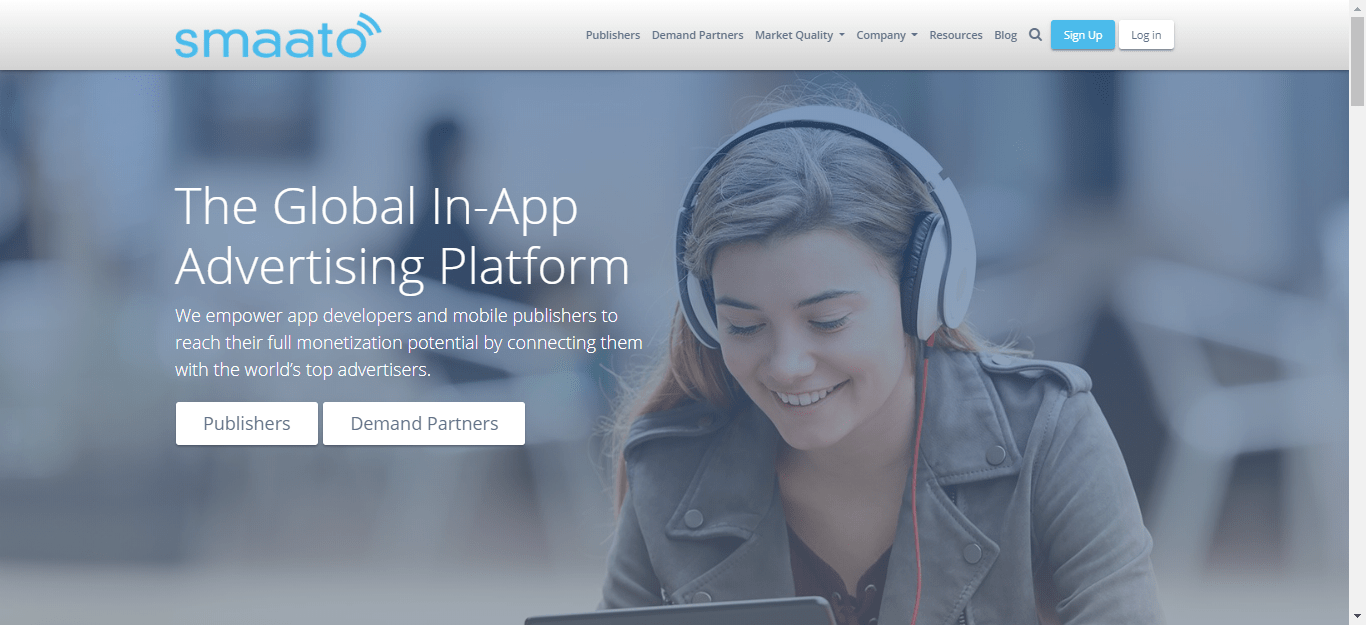
Smaato is another name that comes to mind when talking about real-time bidding and programmatic advertising. It’s a strong player when it comes to high revenues for developers of mobile apps and websites.
Smaato Publisher Platform offers a “Dynamic Demand” platform that enables per-impression competition for all advertising sources to maximize publisher revenue.
Smaato is connected to over 390 demand partners and their platform is free to integrate, so no real downsides exist in their application, and the revenue potential looks promising, given that you catch the fancy of the demand partners.
Pros
- Offers a high level of transparency
- Gives access to premium inventory from around the world
- Provides relatively high eCPM for publishers
Cons
- Publisher unfriendly interface
- Doesn’t take responsibility of ad content presented by the advertisers
- No representations about the number of clicks or impressions an ad will receive.
9. Chartboost
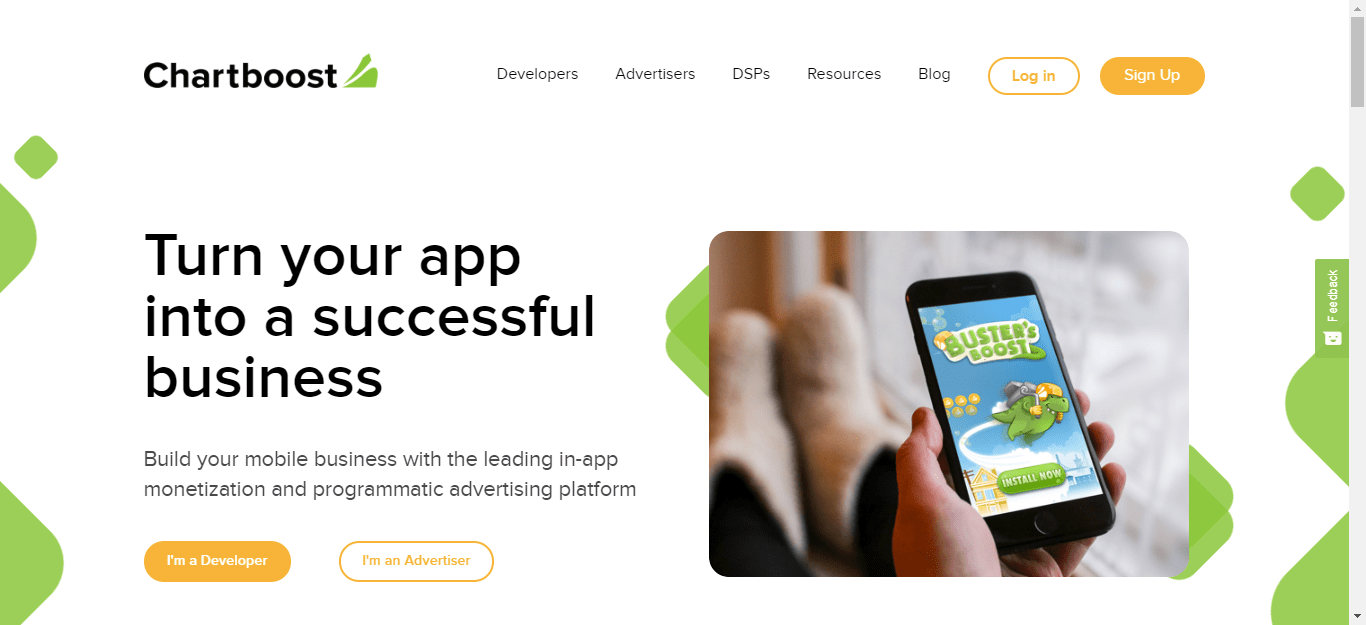
After you first strike gold with an app, you want to keep your current fan base aware of your new apps, which is why cross-promotion of your new apps in your existing applications is a powerful and popular solution for increasing downloads and profits. This is why Chartboost has gathered an impressive group of mobile game developers as its clients, ranging from the likes of Rovio to DirtyBit.
Chartboost excels in cross-promotion but also offers the most popular mobile-only ad platform for gaming apps. They state that they work with 90% of the developers of the top 10 grossing mobile games. If you are a game developer then Chartboost offers a lot of potential for your ad ventures. They promote the ability of their partnering developers to make intelligent decisions regarding their ad campaigns based on their transparent and data-driven platform.
Pros
- Offers both interstitial and video ads and the integration has been made extremely simple; a single SDK suits all channels of ads.
- The developer gets to keep between 90% and 100% of the revenue, which is an astonishingly high figure.
- Allows you to see who advertises in your app and gives you full control in deciding who is allowed to do so and who is not.
- Publicizes a list of CPIs across the globe on its website, which supports its transparency policy.
The only cost of using Chartboost is the 10% cut they charge you per transaction they handle on your behalf.
Cons
- Publishers can incur payment delays
- Before publishers can get paid, they must meet a minimum requirement of $75, while wire transfers require a minimum of $300
10. Unity Ads & Ironsource
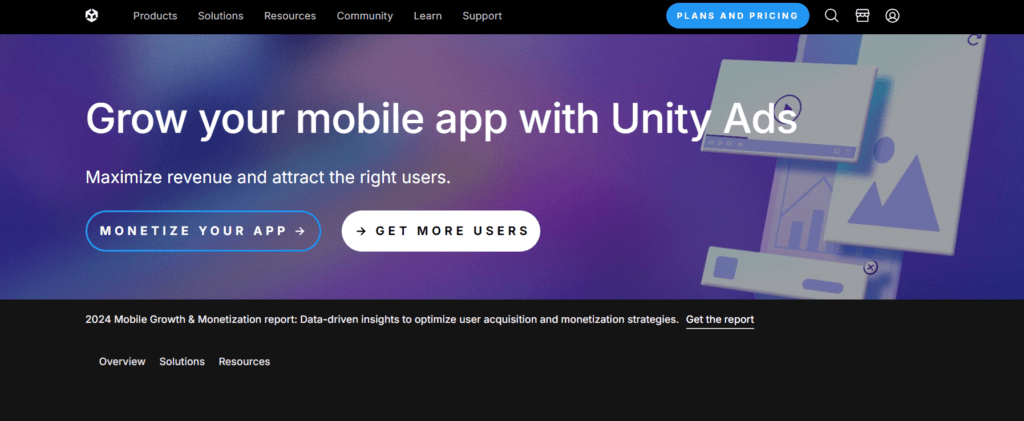
Both Unity ads and Ironsource are now under one roof, so. Combining Unity’s user-friendly game development integration with IronSource’s advanced ad mediation and analytics, this platform offers a comprehensive suite for developers.
Unity Ads is the perfect choice for publishers who are looking for a gaming-centric ad network. It comes with more than 60 demand sources from a single SDK. Whether you’re looking to commence your in-app advertising journey with in-app, or trying to set up IAP (in-app purchases), Unity Ads have the tools and resources to help you reach your app advertising goals.
Unity Ads offers a range of features, including the Tapjoy Offerwall—a rewarded ad unit that functions as a marketplace. It allows users to earn in-app currency by completing various in-game tasks.
Talking about Ironsource, running on the CPM payment model, Ironsource supports multiple ad formats like Rewards Video, Playable, Interstitial, Native, Video, Banner, and Overwall ads.
Pros
Offers Tapjoy, which dominates the offerwall market, boasting eCPMs for Android in the US that surpass $1,000.
Offers diverse ad formats like interstitials, rewarded videos, banners, native ads—catering to various user experiences.
Offers detailed insights, allowing for data-driven decision-making.
Cons
With the merger, there might be temporary delays in support as they streamline operations.
11. TapJoy by Ironsource
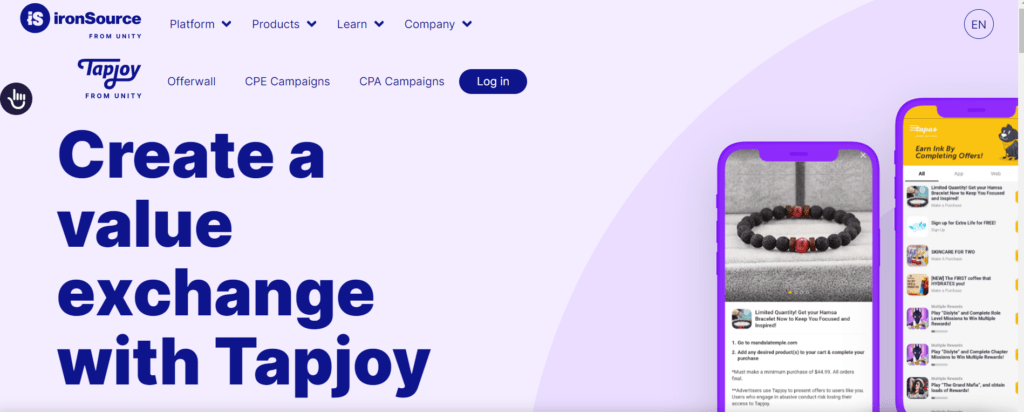
TapJoy is one of the most famous mobile ad networks after ChartBoost, especially for gaming apps. The network offers high user traffic, which gets converted into higher engagement and subsequently, higher conversion rates. The company has now been taken over by IronSource.
Features:
- Offers virtual currency for watching ads to app users
Pros
- Adequate technical support for publishers
- Offers a wide range of ad formats like offerwall ads, interstitial ads, or video ads
- Can easily handle large traffic volumes
Cons
- Some users find TapJoy’s interface confusing and hard-to-navigate
- Inadequate rewards awarded for watching video ads
12. Digital Turbine
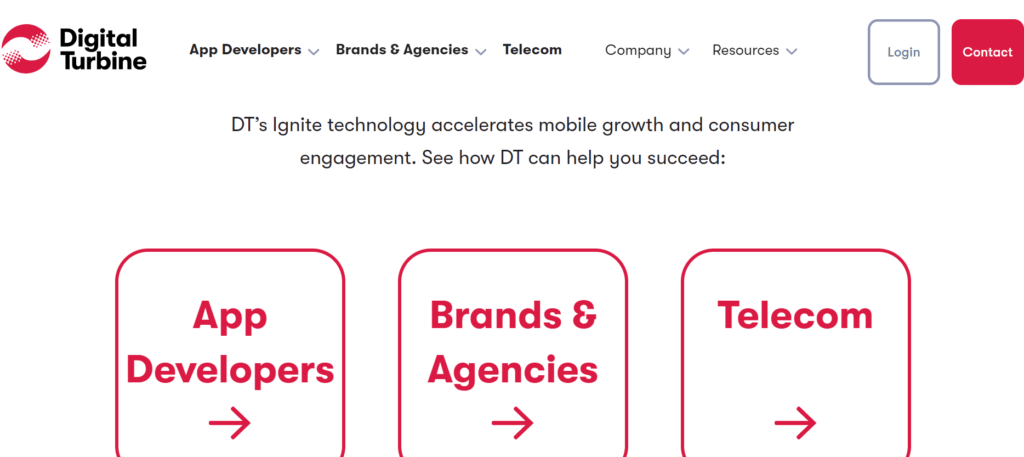
Another mobile ad network in the list, Digital Turbine, which has recently acquired Adcolony, offers a transparent, revenue-optimized mediation platform designed to maximize publisher earnings.
With simple auction mechanics, it ensures real-time, guaranteed bids from ad networks and DSPs, enabling the highest bid to win through a unified auction.
Moreover, its non-intrusive rewarded ad format allows publishers to monetize their entire user base while complementing IAP revenue with seamless app integration. As a leading monetization platform, Digital Turbine balances high eCPMs with a positive user experience across all ad formats, connecting apps to both performance and brand demand.
Pros
- Offers an array of segmentation and targeting options
- Provides sophisticated Mediation, Exchange and Offer Wall
- Has advertisers from around the globe
Cons
New users might face a learning curve to fully utilize all the features and tools available
13. MobFox
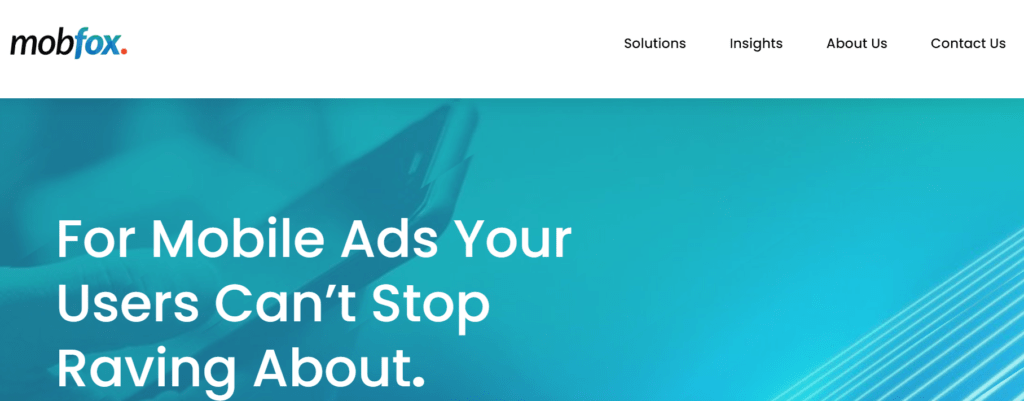
MobFox, apart from being a mobile ad network, also functions as an ad exchange and performance agency, providing all-in-one solutions for publishers. The mobile ad network offers SDK integration that is compatible with almost all the major ad formats like interstitial ads, video ads, rich media ads, etc.
Features
- Offer custom audience segmentation creation functionality
- Offers all major ad formats
- Is a programmatic ad network
Pros
- Has anti-fraud measures
- Offers private marketplaces
- Offers advanced retargeting options
Cons
- Min payout starts from $100
14. SnapChat Ad Network
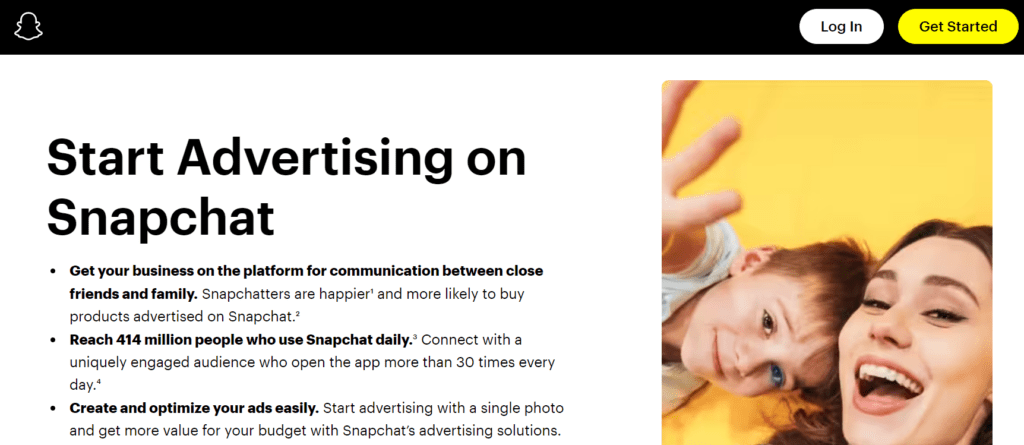
Snapchat mobile ad network is used for targeting precisely millennials and Gen-Z. Currently hosting 406 million users, it is one of the best ad mobile networks we have at present. If the ads are aesthetic and enticing enough, they can surely grasp the user’s attention and provide high visibility.
Pros
- Targets the tech-savvy generation
- Has advanced targeting functionalities like lookalike audiences, retargeting, pr uploading users list
- Cheaper option compared to others
Cons
- Sharing feature is complex compared to other social media platforms, which can hinder posts (ad in this case) sharing
- Much smaller user base due to niche targeting
- Ads can be skipped without the advertiser knowing
15. AppLovin
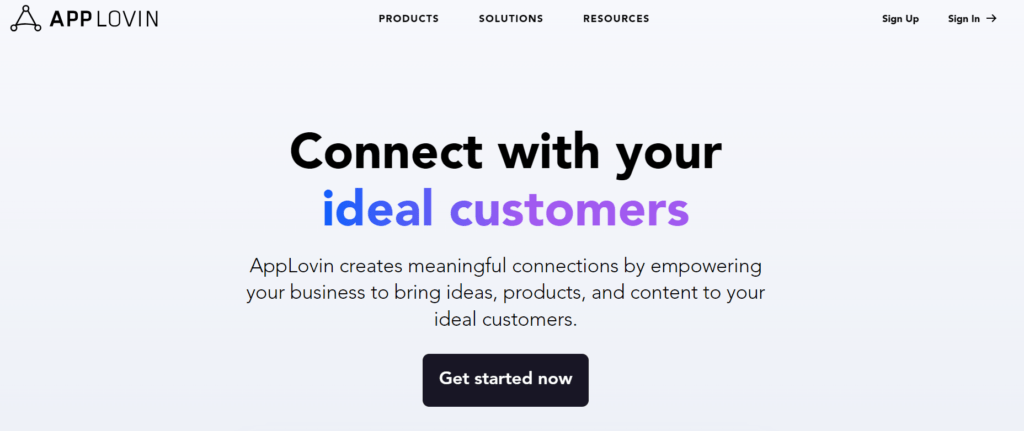
AppLovin is one of the largest mobile ad networks in the programmatic marketing industry. It uses both source-based and user-based data to provide greater understanding of user patterns. Applovin is regarded as one of the best mobile ad networks for both publishers and advertisers. Founded way back in 2012, Applovin has been in the industry for a long time and it currently has a network coverage of more than 1.5 billion devices.
As a publisher, you can trust the network to provide you with a wide reach and tools to optimize your earnings. The company’s header bidding process allows multiple advertisers to bid on inventory, leading to higher revenue.
It also offers performance-based advertising campaigns, which improve the targeting of ads, making a win-win deal for both advertisers and publishers.
Applovin recently acquired Mopub, another mobile advertising company. This acquisition makes it even more capable of handling the needs of publishers.
Features
- Offers event-optimized UA campaigns
- Supports a variety of ad formats like skippable or non-skippable ads, reward ads, banner ads, etc
- Connects with over 1.5 billion devices on a monthly basis
Pros
- Offer real-time app analytics
- Comes with brand safety tools to report problem-causing ads or content
Cons
- Low eCPM and fill rates
- Difficulty in creating account with the platform
16. Propeller Ads
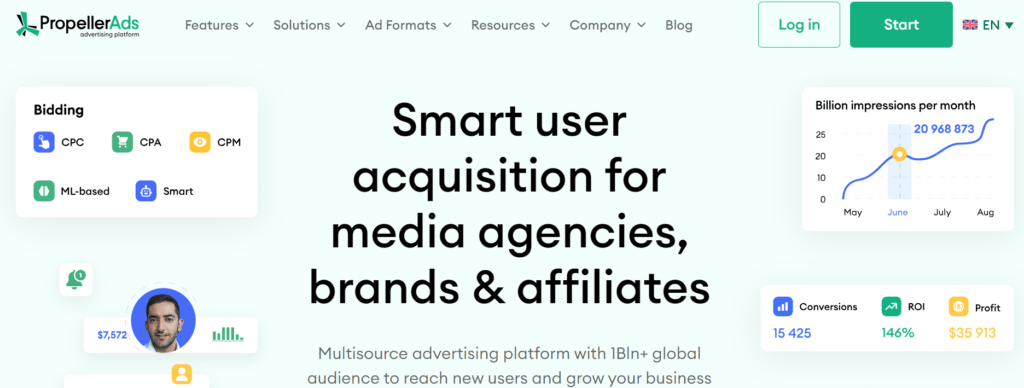
Another one of the best mobile advertising networks in the list is Propeller ads. It’s a diverse advertising platform offering multiple optimizing options for both advertisers and publishers alike. Its mobile ad network hosts over one billion users all around the globe, a number that can help in scaling up the business.
Features
- Offers AI-based bid selection
- Offers multiformat CPA goal campaigns
- Minimum payment threshold is $5
Pros
- No minimum traffic requirement
- Offers a wide range of payment options
Cons
- Lower CPM if the app’s UI/UX design doesn’t the quality standards
- Lower revenue for non-English language apps
17. Liftoff
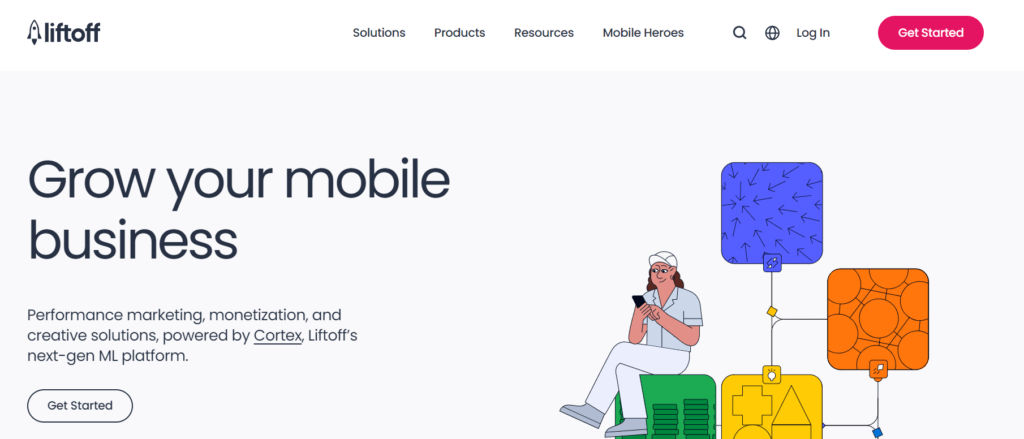
Another mobile ad network in the list is Liftoff. The platform claims to provide mobile app developers/publishers with opportunities to increase revenue by placing their inventory in front of global, high-bidding advertisers. This ensures maximum fill rates and boosting ARPDAU (Average Revenue Per Daily Active User ) through real-time auctions with ad networks and DSPs.
It also supports high-quality, tech-optimized creatives that integrate seamlessly into apps without affecting user experience. What does a web developer do? A web developer ensures these integrations function properly by coding and optimizing the app’s structure. Additionally, Liftoff offers a user-friendly platform that enables app developers to control, adjust, and monitor ads, helping to balance monetization efforts with maintaining a smooth user experience.
Pros
- Litoff offers a vast collection of over 150,000 apps, including 93% of the top 100, providing ample options for advertisers.
- Litoff comes with lightweight SDK, which is simple to integrate into your app, minimizing development time and effort.
- Litoff offers diverse ad formats for enhanced user experience and retention.
Cons
- Setting up Litoff can be challenging for non-technical users, as it requires understanding and configuring multiple settings and integrations.
Now that you know about some of the best mobile advertising networks, let’s understand their business or payment models.
Mobile Ad Network Business Models
1. Cost-per-mile (CPM)
The most common business model, CPM method, charges advertisers each time their ad is shown to the user on a publisher’s website. The advertisers are charged for every 1000 ad impressions or everytime the ad gains 1000 views, irrespective of any engagement with the ad. CPM model is highly profitable for publishers with a robust traffic flow as they can even forecast their revenue.
2. Cost-per-click (CPC)
Under the CPC model, the advertiser is charged only when the user clicks on the ad. Here, the publishers are at the risk of losing money on the impressions that the ad gains on their website as only the clicks are taken into consideration for remuneration.
3. Cost-per-install (CPI)
Similar to the CPC model, the CPI model pays the publisher only when the ad click is converted into a download, i.e., the user downloads the app after clicking on the ad. The CPI model is of prime importance for app developers as it helps in forecasting the cost of consumer acquisition.
4. Cost-per-action (CPA)
You can consider CPA as an advanced version of CPI. Here, the publisher is paid on the basis of the action taken by the user within an app post download. It can be in the form of subscriptions, in-app purchases, registrations, completing a tutorial, etc.
5. Cost-per-view (CPV)
The CPV business model is used primarily for video ad campaigns wherein the publishers are paid every time a user views the video ad served on their website.
Why Should You Advertise on Mobile Apps?
Many studies and research have conclusively demonstrated significant enhancements in publisher revenue and effective marketing for advertisers through in-app advertising.
Let’s delve into the data that attests to the power of mobile advertising.
- In-app ads perform 11.4 times better than banner ads on mobile websites (AppSavvy).
- 92% of Facebook’s ad revenue comes from mobile advertising (TechJurry).
- 89% of people are more likely to recommend a brand after a satisfactory mobile experience (Think With Google).
- 250 billion apps were downloaded in 2021, and it was expected to increase to nearly 300 billion by the end of 2023 (Statista).
All in all, combining these statistics and insights showcases the undeniable value and potential of in-app mobile advertising.
Now you must be wondering which mobile ad network pays the most. There are many factors app owners need to take into consideration to find the best mobile ad networks. Here are some of them:
Which Mobile Ad Network is Right for You: Top 10 Factors to Consider
With all the best mobile ad networks for publishers out there, it can be pretty perplexing to choose one. To help eliminate this confusion, focus on what you need and how your needs fit that particular mobile ad network.
Find out which offers better targeting abilities, better quality graphics in multiple ad formats, better prices, and more. Let’s take a closer look.
1. Target Audience
Understand your target audience and ensure the ad network effectively reaches the desired demographic. Consider geographic location, age group, interests, and behavior to align your ads with the right audience.
2. Ad Formats
Evaluate the ad formats supported by the network. Determine whether they offer a variety of formats like banners, interstitials, native ads, or video ads to suit your campaign goals and engage users effectively.
Interstitial Ads
Interstitial ads are the ads that cover the full-page of your device screen. These ads are generally employed naturally in-between page transitions or app screens. While the ad impressions and CTR is high, they can come across as intrusive or can even lead to falsely elevated CTR due to accidental clicks.
Banner Ads
They are one of the oldest and traditional ad formats. Banner ads can either be static or animated, and are generally used for brand awareness or drive traffic to the advertiser’s domain.
Native Ads
As the name suggests, native ads blend to the content present on the user’s screen to come across as less intrusive. They can either be textual or animated in nature.
OfferWall Ads
An offer wall is a method of app monetisation where users are rewarded for fulfilling particular tasks within an app. They are mainly employed for advertising third-party applications.
Rich Media Ads
Rich media ads, as the name suggests, consist of various ad elements like audio, video, images or texts to make the ads more appealing to the viewers.
3. Ad Quality and Relevance
Look for an ad network that emphasizes high-quality and relevant ads. Ensure the network maintains strict standards to deliver ads that align with your brand image and resonate with your target audience. It’s because it ultimately helps drive higher engagement and conversions.
4. Mobile Ad Targeting
Assess the network’s targeting capabilities, including demographic, contextual, device, or behavioral targeting options. Robust targeting options allow you to refine your audience reach and deliver tailored ads to the right users at the right time.
- Geo: To target an audience from a specific geographic location like region, continent, country etc.
- Device: To choose on which mobile devices the ads are to be shown as each mobile device has different processing capabilities to render ads (especially heavy formats like interstitial ads or rich media ads)
- Carrier: For showing ads to users using a specific mobile carrier
- Operating System: To display ads to an audience using a specific operating system (Windows, Android, iOS)
- Connection: For showing ads to users based on their internet connection (4G, 5G, Wi-fi)
- Interests: For narrowing down the target criteria and show ads to a specific group of users with a specific interest
- Gender: Using gender to segment and target the users (Shaving blade ads to males or sanitary napkins ads to females)
5. Mobile Network Reporting
Consider the ad network’s track record and performance metrics. Evaluate key performance indicators (KPIs) such as click-through rates (CTR), conversion rates, viewability, and overall campaign performance to gauge the effectiveness of the network in delivering desired results.
6. Ad Inventory and Fill Rate
Examine the network’s ad inventory size and availability across different platforms and regions. Additionally, consider the network’s fill rate, which indicates the percentage of ad requests successfully filled with ads. A higher fill rate ensures maximum ad monetization opportunities.
7. Pricing Model
Understand the pricing model offered by the ad network, whether it’s based on CPM (Cost per Thousand Impressions), CPC (Cost per Click), or CPI (Cost per Install). Also, review the payment terms, frequency, and minimum payout thresholds to ensure they align with your financial goals and expectations.
8. Support Provided
One of the important factors in choosing a mobile ad network is the type of integration it provides. Many mobile ad networks provide SDK integration that simplifies the process of serving ads. However, the complexity of such integrations can vary from ad network to ad network.
Seek out networks that provide thorough, easy-to-follow instructions and quick, helpful technical support to help with any integration difficulties.
9. App Traffic
Many ad networks have varied criteria for accepting publishers into their network – one of them being app traffic. Certain premium ad networks are specific about the quality and quantity of app traffic – if it’s too low or the traffic flow has bot traffic, the ad network may not consider you.
10. Flexibility
An important factor to consider is whether the ad network also offers bidding or just fixed CPM. If the ad network offers bidding, then the publisher can adjust their floor price according to the market demand. Or else, they may have to commit to a set CPM offered by the ad network.
Final Thoughts
Now you must be wondering which mobile ad network is best. Features such as analytics and control panels are standards for mobile ad networks today, but you should compare the differences between them, as all platforms do some things better than others.
The networks listed here are reliable networks that handle billions of ad impressions every month.
Whichever network you choose to go with, just remember that you can always switch to a different network if you are not 100% satisfied with your initial choice. These networks are highly competitive, and thus changing from one network is made as easy as possible, with SDKs that are extremely easy to integrate.
Testing between two or three networks is also a smart decision to make in a situation where you are uncertain of the best network to deploy for your app.
Choosing the right network for your application is not an easy task, but hopefully, this list of 17 best mobile ad networks makes it a little easier for you.
Frequently Asked Questions: Mobile Ad Networks
Mobile ad networks are platforms that connect advertisers and publishers in the mobile advertising ecosystem. They facilitate the buying and selling of mobile advertising space, enabling advertisers to reach their target audience through mobile apps and websites.
Google AdMob is a popular example of a mobile ad network. It connects advertisers with app developers and publishers, offering various ad formats and targeting options to reach the target audience on mobile apps and websites.
According to Statista, the most popular and one of the largest mobile ad networks is Google Ads Admob.
Mobile ad networks connect advertisers with publishers that function through an app. They aggregate inventory from mobile app publishers at a fixed eCPM and sell it to advertisers based on their requirements.
There are quite a few mobile ad networks that pay relatively high eCPM, such as Media.net, AdPushup, and Chartboost.
– CPC (Cost-per-click): Publishers are paid every time a user clicks on the ad.
– CPM (cost-per-mille): Publishers are paid for every thousand impressions on the ad.
– CPA (Cost-per-action): Publishers are paid only when a user completes a pre-determined action through the ad, like registrations
Key metrics like return on ad spend (ROAS), conversion rate (CR), click-through rate (CTR), cost per acquisition (CPR), and lifetime value (LTV) are used to assess the effectiveness and success of mobile ad campaigns.
Publishers and advertisers can adhere to data privacy standards by following the data guidelines set by GDPR and CCPA. Moreover, they can also move to first-party data targeting or adopting PPIDs to secure user data even further.
Yes, it is possible to integrate multiple ad networks via SDK integration or mediation platform. This optimizes revenue by automatically selecting the network that pays the highest for an impression.
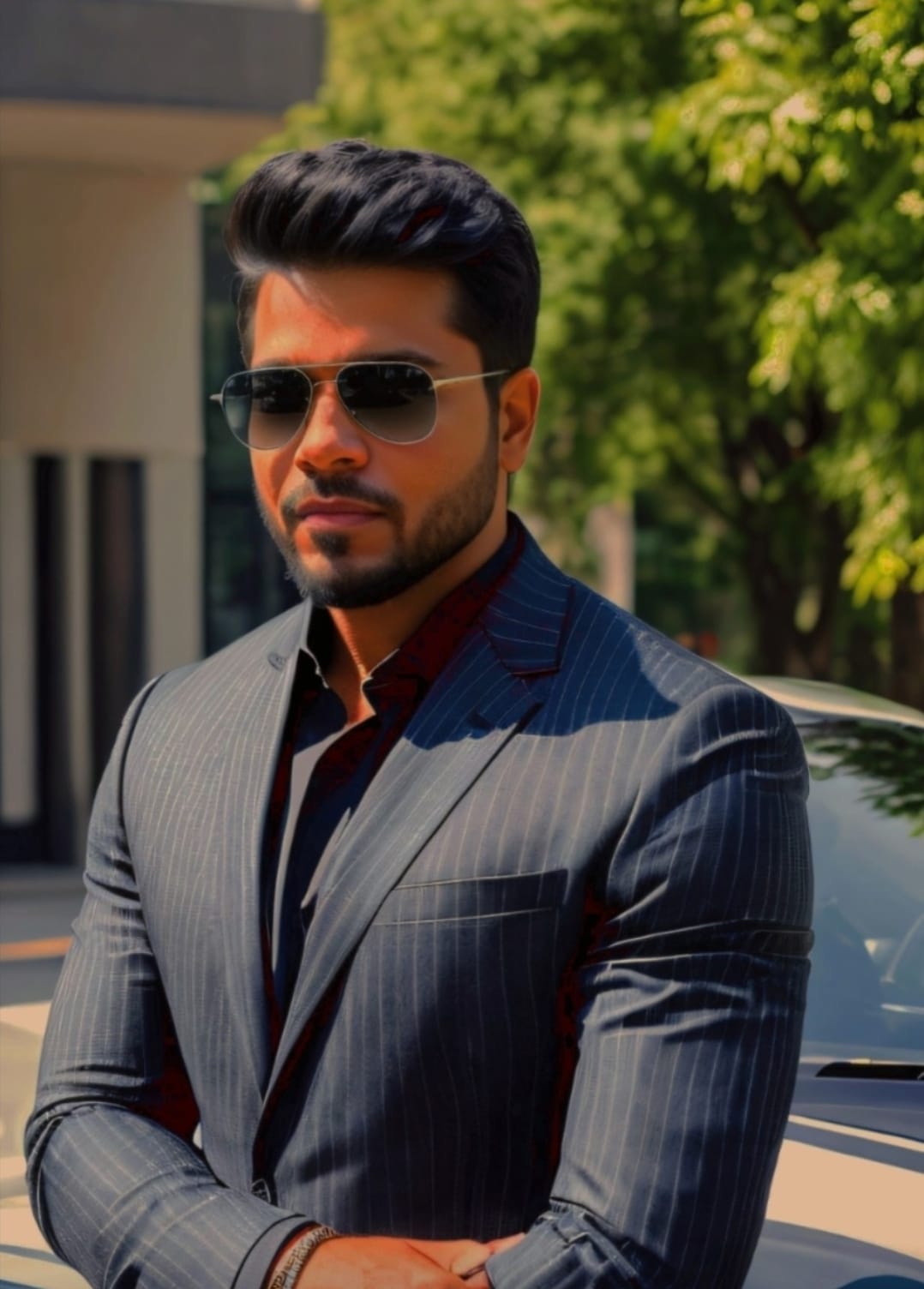
Deepak has a keen eye for detail and a deep understanding of the ad tech landscape. Whether it’s through in-depth articles, thought-provoking insights, or compelling storytelling, he’s dedicated to helping people navigate the complex world of ad tech with the simplicity of his words.
![Top 17 Highest-Paying Mobile Ad Networks + [Expert Tips on Choosing one] mobile ad networks](https://www.adpushup.com/blog/wp-content/uploads/2024/10/Mobile_Ad_Networks_4_1-2.webp)

